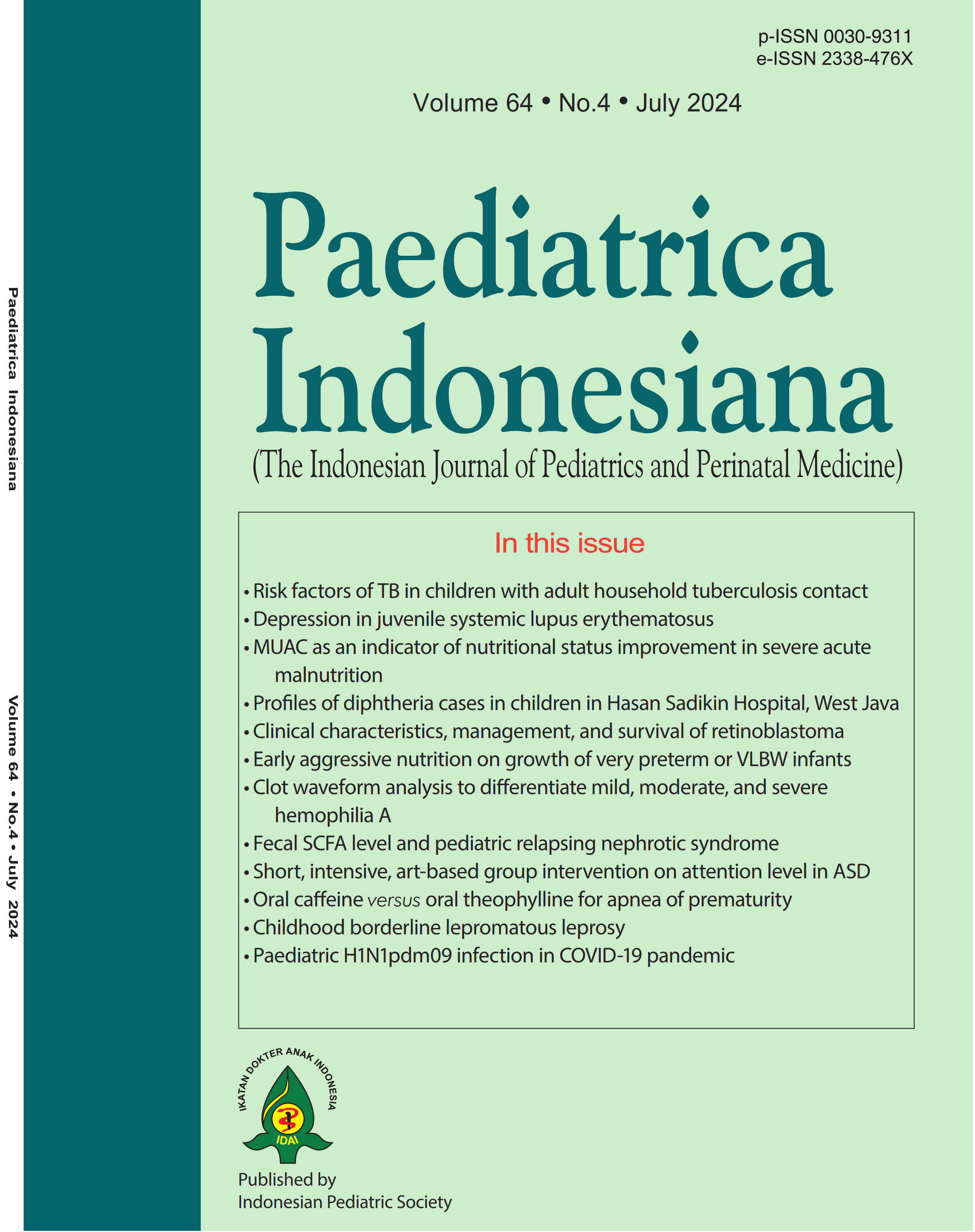The role of early aggressive nutrition on growth of very preterm or very low birth weight infants
Abstract
Background Very preterm infants (<32 weeks gestational age) are at high risk of poor neurodevelopmental outcomes. Early aggressive parenteral nutrition (protein ³ 2g/kg/day) can reduce the incidence of malnutrition in very preterm infants. At present, Fatmawati General Hospital does not have a standard nutritional protocol for preterm infant.
Objective To determine the difference in growth (days to regain birth weight and growth velocity) of very preterm (<32 weeks gestational age) or very low birth weight (VLBW) (<1500g) infants who were born and hospitalized in the Neonatal Unit of Fatmawati General Hospital, Jakarta, before and after applying early aggressive parenteral nutrition using a nutrition protocol from Cipto Mangunkusumo Hospital, Jakarta.
Methods A quasi-experimental study was conducted on 23 very preterm or VLBW infants in the Neonatal Unit of Fatmawati General Hospital, from July to November 2019. Control group data were taken from medical records of very preterm or VLBW babies discharged from our unit from January 2018 – to June 2019 and compared to those of the intervention group.
Results The intervention group regained their birth weight significantly faster than the control group [mean 7.43 (SD 3.5) vs. 16.73 (SD 5.1) days, respectively; (P=0.00)]. Mean growth velocity was also significantly higher in the intervention group than in the control group [14.6 (SD 6.0) vs. 8.9 (SD 6.9) gram/kg/day, respectively; (P=0.002)].
Conclusion Provision of early aggressive parenteral nutrition reduces the time to regain birth weight and leads to higher growth velocity in very preterm/VLBW infants.
References
2. Stephens BE, Walden R V, Gargus RA, Tucker R, McKinley L, Mance M, et al. First-week protein and energy intakes are associated with 18-month developmental outcomes in extremely low birth weight infants. Pediatrics. 2009;123:1337–43. DOI: https://doi.org/10.1542/peds.2008-0211
3. Su B-H. Optimizing nutrition in preterm infants. Pediatr Neonatol. 2014;55:5–13. https://doi.org/10.1016/j.pedneo.2013.07.003
4. Thureen PJ, Hay WW Jr. Early aggressive nutrition in preterm infants. Semin Neonatol. 2001;6:403–15. DOI: https://doi.org/10.1053/siny.2001.0061
5. Hay Jr WW, Brown LD, Denne SC. Energy requirements, protein-energy metabolism and balance, and carbohydrates in preterm infants. World Rev Nutr Diet. 2014;110:64–81. DOI: https://doi.org/10.1159/000358459
6. Clark RH, Thomas P, Peabody J. Extrauterine growth restriction remains a serious problem in prematurely born neonates. Pediatrics. 2003;111:986–90. DOI: https://doi.org/10.1542/peds.111.5.986
7. Ruth VA. Extrauterine growth restriction: a review of the literature. Neonatal Netw. 2008;27:177–84. DOI: https://doi.org/10.1891/0730-0832.27.3.177
8. Ikatan Dokter Anak Indonesia. Konsensus asuhan nutrisi pada bayi prematur. Jakarta: BP IDAI: 2016.
9. Sjarif DR, Rohsiswatmo R, Rundjan L, Yulianti K. Panduan berbasis bukti asuhan nutrisi untuk bayi prematur. EC000202061182. 2020.
9. Ikatan Dokter Anak Indonesia. Kadim M, Roeslani R, Nurmalia L, eds. Konsensus asuhan nutrisi pada bayi prematur. Jakarta: Badan Penerbit IDAI; 2016.
10. Goldberg DL, Becker PJ, Brigham K, Carlson S, Fleck L, Gollins L, et al. Identifying
malnutrition in preterm and neonatal populations: recommended indicators. J Acad Nutr Diet. 2018;118:1571–82. DOI: https://doi.org/10.1016/j.jand.2017.10.006
11. Törer B, Hanta D, Özdemir Z, Çetinkaya B, Gülcan H. An aggressive parenteral nutrition protocol improves growth in preterm infants. Turk J Pediatr. 2015;57:236-41. PMID: 26701941.
12. Fenton TR, Anderson D, Groh-Wargo S, Hoyos A, Ehrenkranz RA, Senterre T. An attempt to standardize the calculation of growth velocity of preterm infants—evaluation of practical bedside methods. J Pediatr. 2018;196:77–83. DOI: https://doi.org/10.1016/j.jpeds.2017.10.005
13. Ziegler EE, Carlson SJ. Growth failure due to inadequate protein intake is common among small preterm infants. Nutr Today. 2016;51:228–32. DOI: https://doi.org/10.1097/NT.0000000000000172
14. dit Trolli SE, Kermorvant-Duchemin E, Huon C, Bremond-Gignac D, Lapillonne A. Early lipid supply and neurological development at one year in very low birth weight (VLBW) preterm infants. Early Hum Dev. 2012;88:S25–9. DOI: https://doi.org/10.1016/j.earlhumdev.2011.12.024
15. Vlaardingerbroek H, Veldhorst MAB, Spronk S, van den Akker CHP, van Goudoever JB. Parenteral lipid administration to very-low-birth-weight infants—early introduction of lipids and use of new lipid emulsions: a systematic review and meta-analysis. Am J Clin Nutr. 2012;96:255–68. DOI: https://doi.org/10.3945/ajcn.112.040717
16. Embleton ND. Optimal protein and energy intakes in preterm infants. Early Hum Dev. 2007;83:831–7. DOI: https://doi.org/10.1016/j.earlhumdev.2007.10.001
Copyright (c) 2024 Nadia Dwi Insani, Rinawati Rohsiswatmo, Damayanti Rusli Sjarif, Putri Maharani Tristanita Marsubrin, Klara Yuliarti, Lanny Christine Gultom

This work is licensed under a Creative Commons Attribution-NonCommercial-ShareAlike 4.0 International License.
Authors who publish with this journal agree to the following terms:
Authors retain copyright and grant the journal right of first publication with the work simultaneously licensed under a Creative Commons Attribution License that allows others to share the work with an acknowledgement of the work's authorship and initial publication in this journal.
Authors are able to enter into separate, additional contractual arrangements for the non-exclusive distribution of the journal's published version of the work (e.g., post it to an institutional repository or publish it in a book), with an acknowledgement of its initial publication in this journal.
Accepted 2024-08-30
Published 2024-08-30













